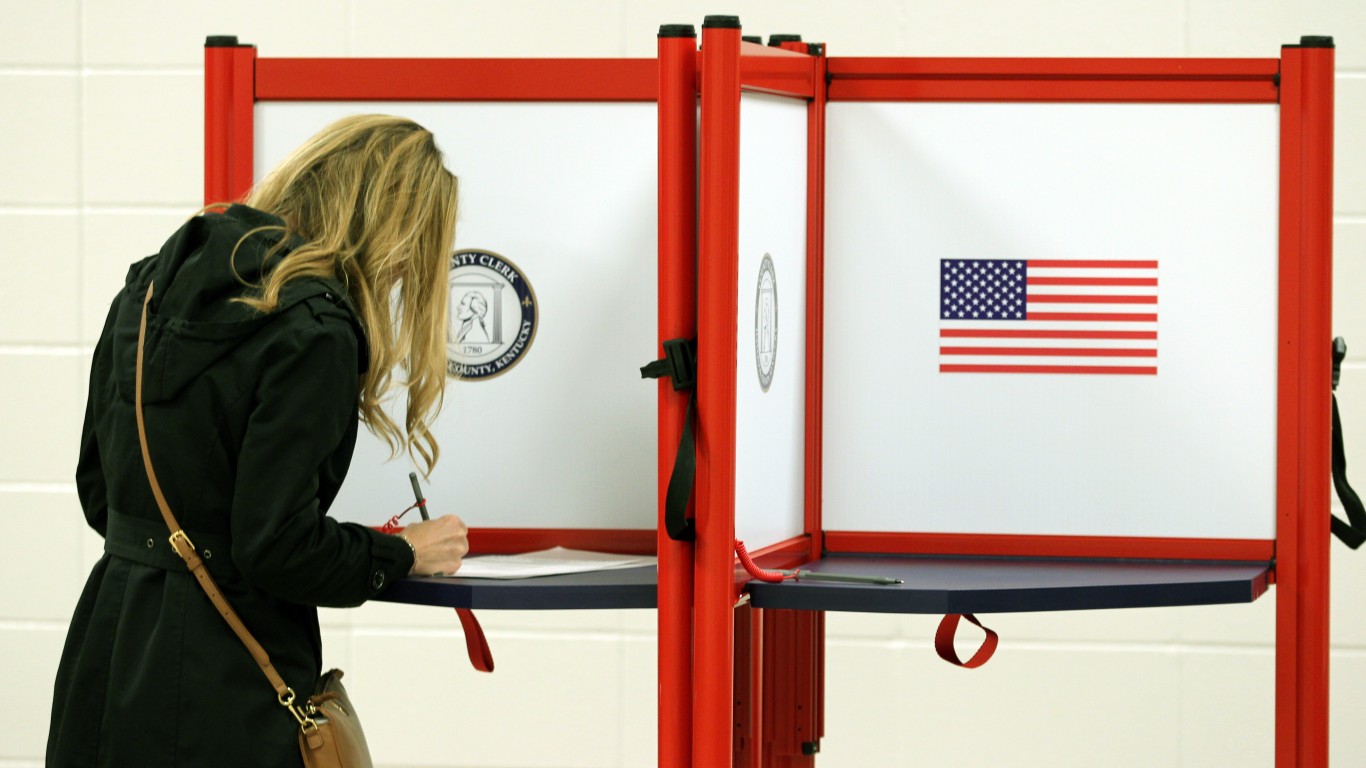
Climate change continues to wreak havoc across the world. Several states are reeling from severe spring flooding, and parts of the country are still recovering from last year’s brutal hurricane season. Meanwhile, a study by Nanjing University of Information Science and Technology released this month found that, as a result of climate change, droughts are now coming on faster than can be predicted. While the effects of the crisis can be seen in every nation on earth, some countries face a much higher threat of catastrophic ecological events than others. (See the most destructive storms in U.S. history.)
To find the 27 countries that face catastrophic ecological threats, 24/7 Wall St. reviewed the global think tank Institute for Economics & Peace report Ecological Threat Report 2022. The report, which covers 163 countries, identified 27 hotspot countries that face catastrophic ecological threats, while also having the lowest levels of societal resilience (as measured by ongoing domestic and international conflict, societal safety and security, and militarization). Countries are ordered by the number of catastrophic ecological threats in reverse alphabetical order.
We added such measures as the Global Peace Index 2022, which is on a scale of 1-5, whereas 5 is least peaceful; gross domestic product per capita in current U.S. dollars; the Human Development Index (the HDI uses health, education, and economic measures to assess a country’s development on a scale of 0-1 with 1 being most developed); and 2021 and projected 2050 population of each country.
Countries with effective water management, efficient agricultural systems, and strong disaster preparedness have the ability to better withstand an ecological disaster. Being free of conflicts further strengthens a country’s resilience. No single country with a high level of socio-economic resilience has an extremely low ETR score. Conversely, countries plagued by ongoing conflicts exhibit less societal resilience and are ecologically fragile. (Are any among the countries facing the worst climate emergencies?)
The 2022 ETR identifies 27 hotspot countries that face catastrophic ecological threats, while also having the lowest levels of societal resilience. These countries are home to 768 million people. Two-thirds of hotspot countries are in sub-Saharan Africa, with seven of the eight hotspot countries with the highest risk found in that region – Burundi, Central African Republic, Chad, Republic of the Congo, Somalia, South Sudan, and Uganda. The eighth country is Yemen.
Meanwhile, countries in the Middle East/North Africa account for another 18.5% of hotspot countries. In addition to natural disasters and unstable societies, many of the hotspot countries face food shortages due to supply disruptions caused by the Russia war in Ukraine.
Click here to see 27 countries that face the worst catastrophic ecological threats.
Click here to read our detailed methodology.
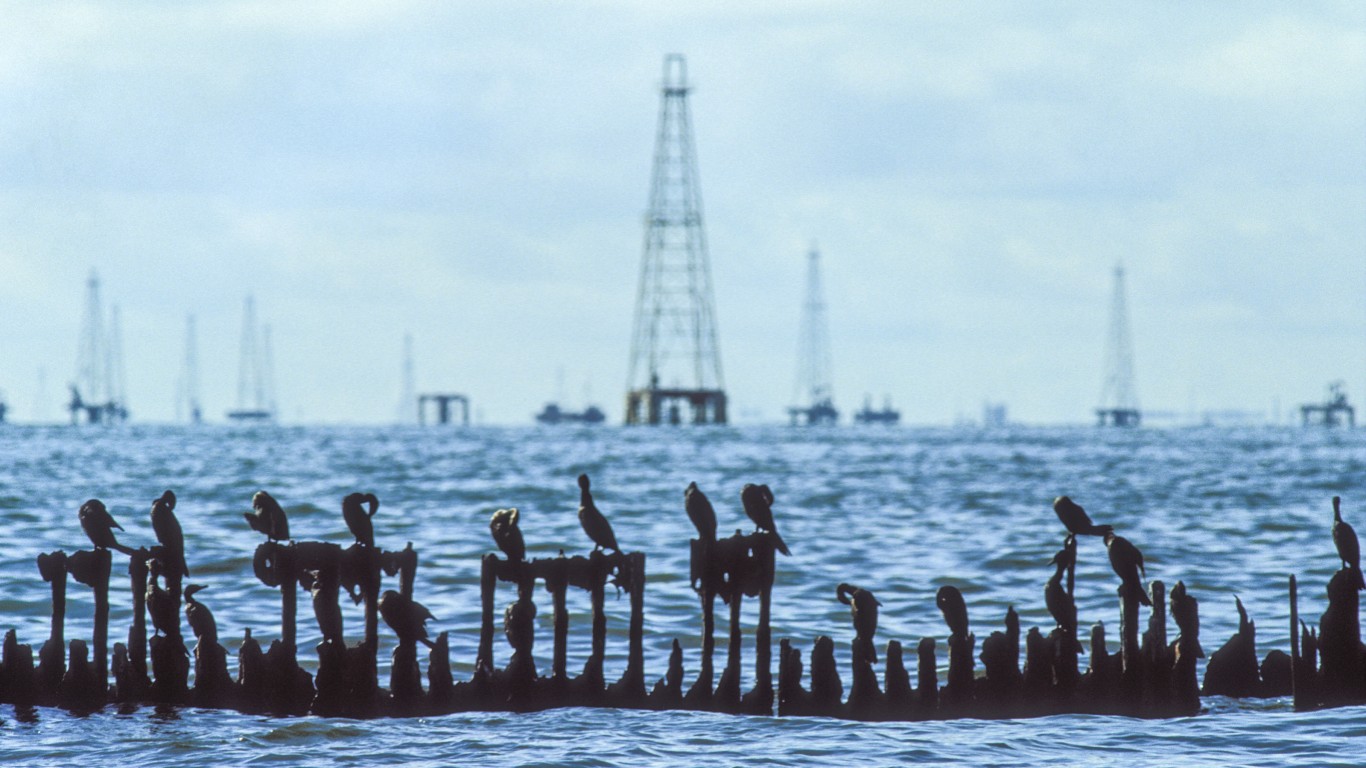
27. Venezuela
> Catastrophic ecological threats: Two: Food Security; Water Risk
> Global peace index, 2022 (1-5, most to least peaceful): 2.284 – #148 of 163 countries
> GDP per capita, 2014: $16,056 – #44 highest of 163 countries
> Human development index: 0.7 – #120 of 191 countries
> Population, July 2021 to 2050: 28.2 million to 35.9 million – 27.4% growth
Escaping violence, diminishing food security, and lack of health care, 6 million Venezuelans have fled their country to neighboring nations in Latin America and the Caribbean, according to the UNHCR, the U.N. Refugee agency. Many are coming to the U.S. In September, U.S. Customs and Border Protection reported 77,302 refugees were from Venezuela, Nicaragua, and Cuba, up 245% from a year ago. In addition, Venezuela is the only South American country projected to face increased water risk by 2040. It is also the country with the highest GDP per capita on the list.
[in-text-ad]

26. Tajikistan
> Catastrophic ecological threats: Two: Population; Water Risk
> Global peace index, 2022 (1-5, most to least peaceful): 2.177 – #92 of 163 countries
> GDP per capita, 2021: $897 – #20 lowest of 163 countries
> Human development index: 0.7 – #122 of 191 countries
> Population, July 2021 to 2050: 9.8 million to 15.2 million – 55.9% growth
Food insecurity plagues Tajikistan. The central Asian country bordering Afghanistan has the highest conflict risk to its food Imports. About 44% of the food the country imports is from low peace countries. Meanwhile, the country, which ranks among the poorest in the world, had among the highest increases in the number of natural disasters since 1981.

25. Sudan
> Catastrophic ecological threats: Two: Population; Water Risk
> Global peace index, 2022 (1-5, most to least peaceful): 3.117 – #154 of 163 countries
> GDP per capita, 2021: $764 – #15 lowest of 163 countries
> Human development index: 0.5 – #172 of 191 countries
> Population, July 2021 to 2050: 45.7 million to 84.5 million – 85.1% growth
The U.N. refugee agency warned in October of an ongoing crisis in Sudan after the fourth consecutive year of record-breaking rainfall and flooding. The agency estimates the disasters have affected 900,000 people as the flood waters destroyed homes and killed livestock. One of the world’s poorest countries is also among the countries that had water conflicts from 2000 to 2019, and such conflicts are expected to continue. The report projects at least nine more for Sudan. The country already ranks 10th lowest in the peace index.
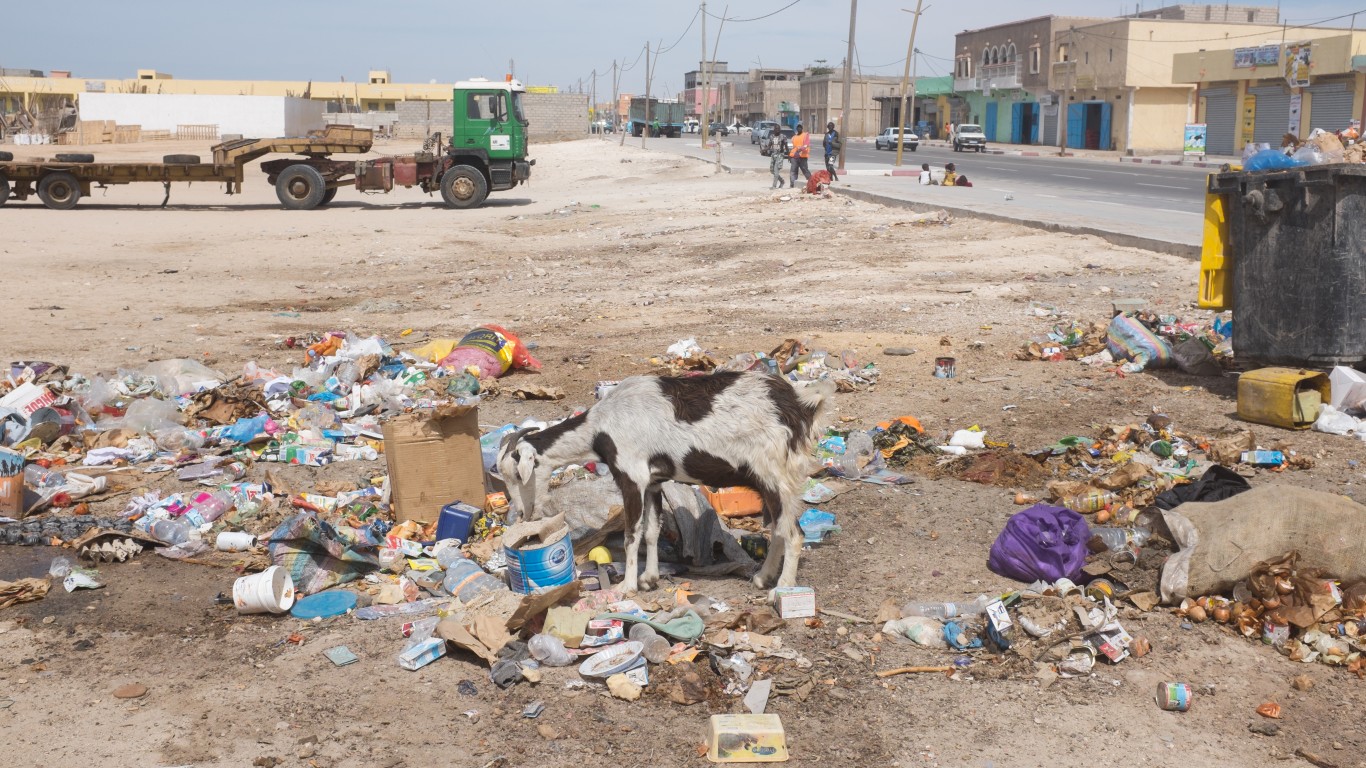
24. Mauritania
> Catastrophic ecological threats: Two: Population; Water Risk
> Global peace index, 2022 (1-5, most to least peaceful): 2.296 – #112 of 163 countries
> GDP per capita, 2021: $1,723 – #40 lowest of 163 countries
> Human development index: 0.6 – #158 of 191 countries
> Population, July 2021 to 2050: 4.6 million to 8.9 million – 93.2% growth
Mauritania’s water risk level is already high, but by 2040, its water challenges are projected to increase even more, the Ecological Threat Report predicts. Mauritania is one of 14 countries projected to face such a hazard over the next 18 years. Mauritania also faces food risk related to its reliance on imports from low peace countries.
[in-text-ad-2]

23. Mali
> Catastrophic ecological threats: Two: Population; Water Risk
> Global peace index, 2022 (1-5, most to least peaceful): 2.313 – #150 of 163 countries
> GDP per capita, 2021: $918 – #21 lowest of 163 countries
> Human development index: 0.4 – #186 of 191 countries
> Population, July 2021 to 2050: 21.9 million to 47.4 million – 116.6% growth
Human Rights Watch reported ethnic violence in central Mali has taken the lives of more than 800 civilians since 2015. In 2020, an ethnic militia killed 35 villagers in Ogossagou. The same village was the site of massacre of 150 people in 2019. Mali is one of 14 countries projected to face the most increased water stress over the next 18 years, which could create about three water conflicts. One of the world’s poorest and least developed countries is also expected to have one of the largest population growth, at more than double from 2020 to 2050.

22. Libya
> Catastrophic ecological threats: Two: Natural Disasters; Population;
> Global peace index, 2022 (1-5, most to least peaceful): 2.467 – #151 of 163 countries
> GDP per capita, 2021: $6,018 – #76 highest of 163 countries
> Human development index: 0.7 – #104 of 191 countries
> Population, July 2021 to 2050: 6.7 million to 8.5 million – 26.8% growth
Although Libya also holds the largest oil reserves in Africa, the country’s frequent floods have hampered its progress. According to the Borgen Project, an anti-poverty initiative, Al-Bayda, Libya, was struck by significant flooding in 2020 that cut off electricity and damaged properties. That followed extreme floods in the Ghat district and southern Libya in 2019. The organization notes that “areas prone to disaster are significantly limited in their progression and development when devastation is so frequent.”
[in-text-ad]

21. Zimbabwe
> Catastrophic ecological threats: Three: Food Security; Population; Water Risk
> Global peace index, 2022 (1-5, most to least peaceful): 2.422 – #127 of 163 countries
> GDP per capita, 2021: $1,737 – #41 lowest of 163 countries
> Human development index: 0.6 – #146 of 191 countries
> Population, July 2021 to 2050: 16.0 million to 26.4 million – 65.3% growth
According to the ETR, Zimbabwe is most at risk for food insecurity. More than 60% of its food imports are from countries riven by conflicts. Moreover, Zimbabwe’s food crisis is exacerbated by frequent dry spells, including a severe drought in the 2018-19 harvest season, USAID reports.
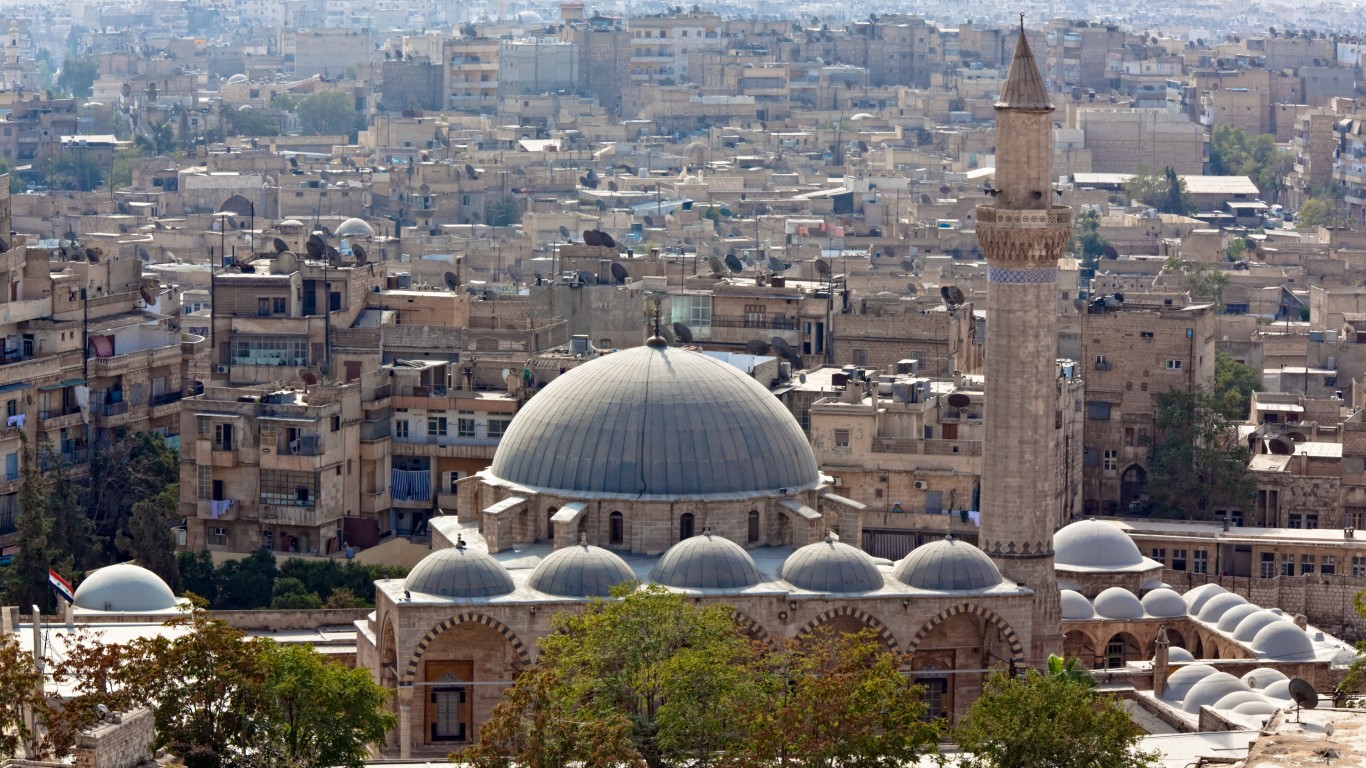
20. Syria
> Catastrophic ecological threats: Three: Food Security; Natural Disasters; Population;
> Global peace index, 2022 (1-5, most to least peaceful): 2.634 – #161 of 163 countries
> GDP per capita, 2018: $1,266 – #32 lowest of 163 countries
> Human development index: 0.6 – #150 of 191 countries
> Population, July 2021 to 2050: 21.3 million to 38.3 million – 79.6% growth
The COVID-19 pandemic has hit Syria hard and impacted its food security. It was also one of the countries with the steepest declines in food security, along with Colombia, Ethiopia, and Mozambique. The civil war in Syria, which started in 2011, is ongoing, with many attributing as contributing factors a long drought and dust storms ahead of the conflict that devastated its agriculture, almost halving the total output of cereal production in the country. The country’s peace index is third lowest.
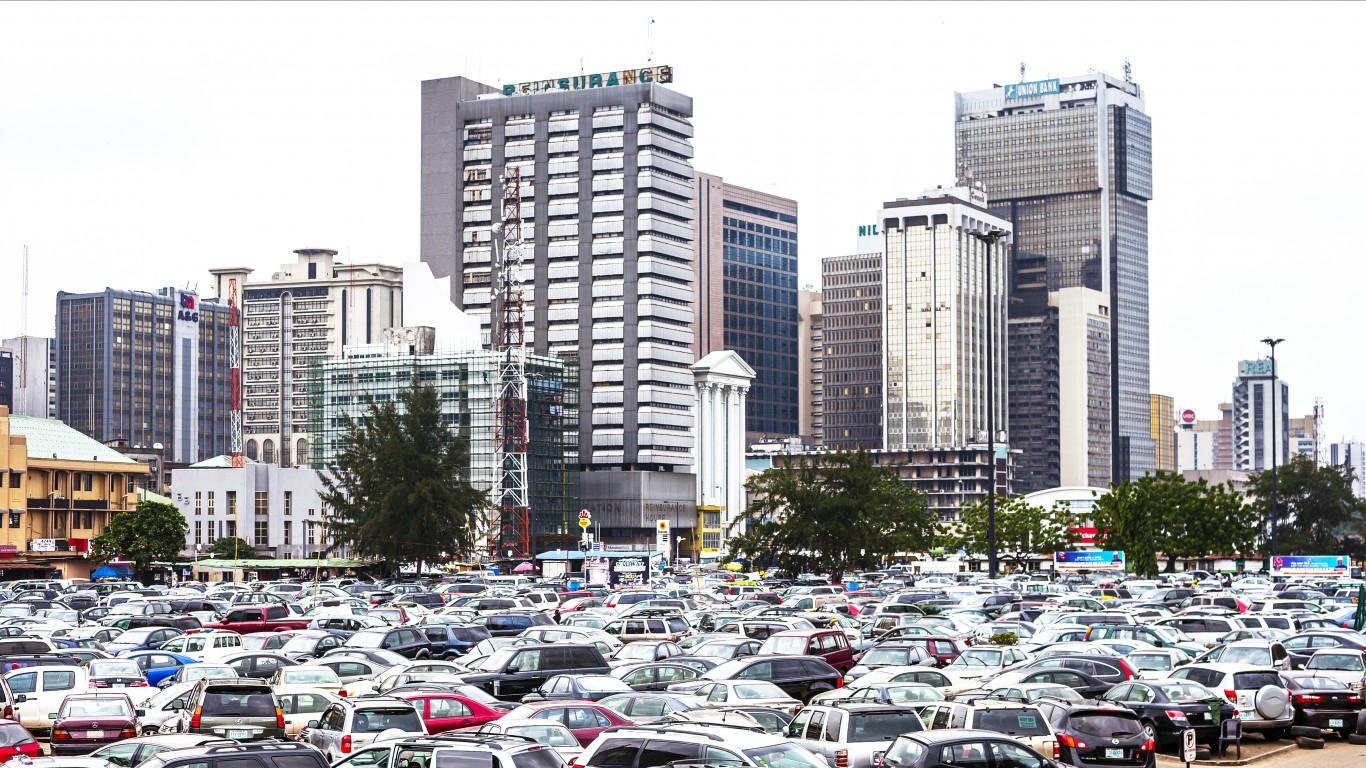
19. Nigeria
> Catastrophic ecological threats: Three: Food Security; Population; Water Risk
> Global peace index, 2022 (1-5, most to least peaceful): 2.581 – #143 of 163 countries
> GDP per capita, 2021: $2,085 – #45 lowest of 163 countries
> Human development index: 0.5 – #163 of 191 countries
> Population, July 2021 to 2050: 213.4 million to 377.5 million – 76.9% growth
In an interesting development for the African nation, Nigeria signed a military cooperation agreement with Russia last year. According to the ETR, Russia has increased its weapons sales to African countries, which accounted for 18% of its arms exports between 2016 and 2020. Nigeria is among the countries that experienced an increase in the number of natural disasters since 1981. It is also among the 14 hotspot countries that will face the most increase in water stress, and it is expected to have at least one water-related conflict by 1980.
[in-text-ad-2]
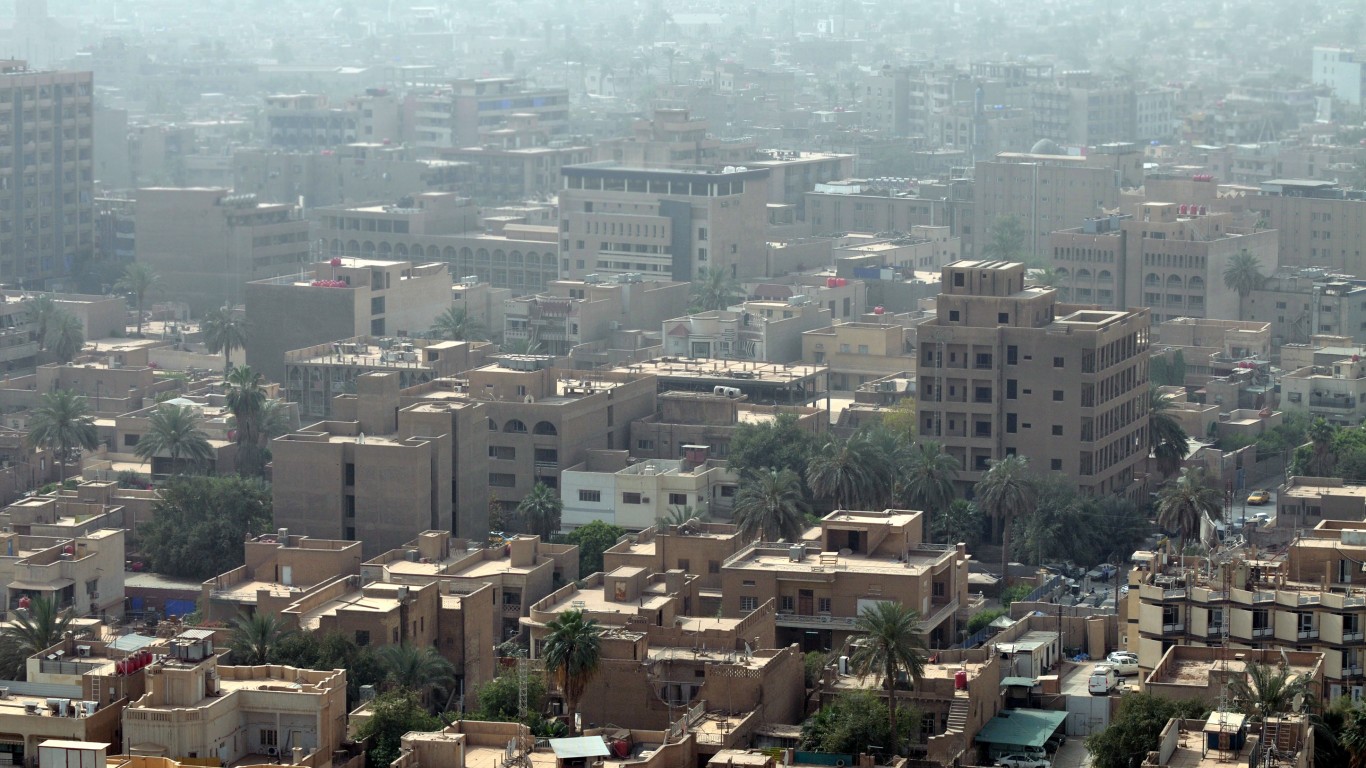
18. Iraq
> Catastrophic ecological threats: Three: Natural Disasters; Population; Water Risk
> Global peace index, 2022 (1-5, most to least peaceful): 3.085 – #157 of 163 countries
> GDP per capita, 2021: $5,048 – #81 lowest of 163 countries
> Human development index: 0.7 – #121 of 191 countries
> Population, July 2021 to 2050: 43.5 million to 74.5 million – 71.2% growth
Conflicts over water is an ongoing concern in the Middle East/North Africa region. Iraq, Turkey, and Syria are all competing for water resources in the Euphrates-Tigris Basin. The report projects Iraq could have 25 more water-related conflicts by 2040 as the country will face some of the greatest increase in water stress by that year. The country’s peace index ranks seventh lowest.
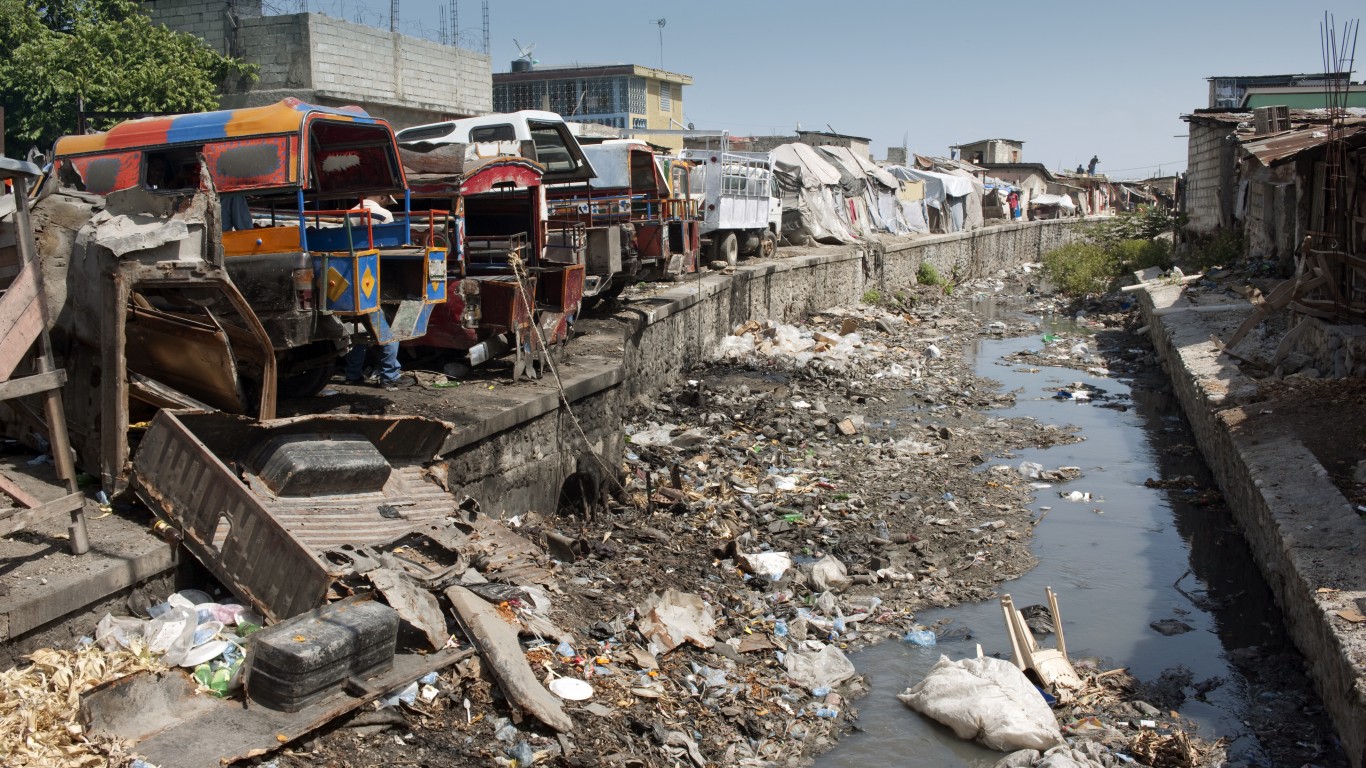
17. Haiti
> Catastrophic ecological threats: Three: Food Security; Natural Disasters; Water Risk
> Global peace index, 2022 (1-5, most to least peaceful): 1.976 – #115 of 163 countries
> GDP per capita, 2021: $1,815 – #42 lowest of 163 countries
> Human development index: 0.5 – #163 of 191 countries
> Population, July 2021 to 2050: 11.4 million to 15.1 million – 31.8% growth
Haiti, the poorest country in the Western Hemisphere, was struck by a 7.2 magnitude earthquake in 2021. Initial reports put the death toll at 2,200 with 12,200 injured and hundreds missing. That followed a devastating 2010 earthquake that took the lives of an estimated 85,000 to 316,000 people. Haiti, which has been experiencing an increase in the number of natural disasters since 1981, is projected to have among the most increase in water stress by 2040
[in-text-ad]
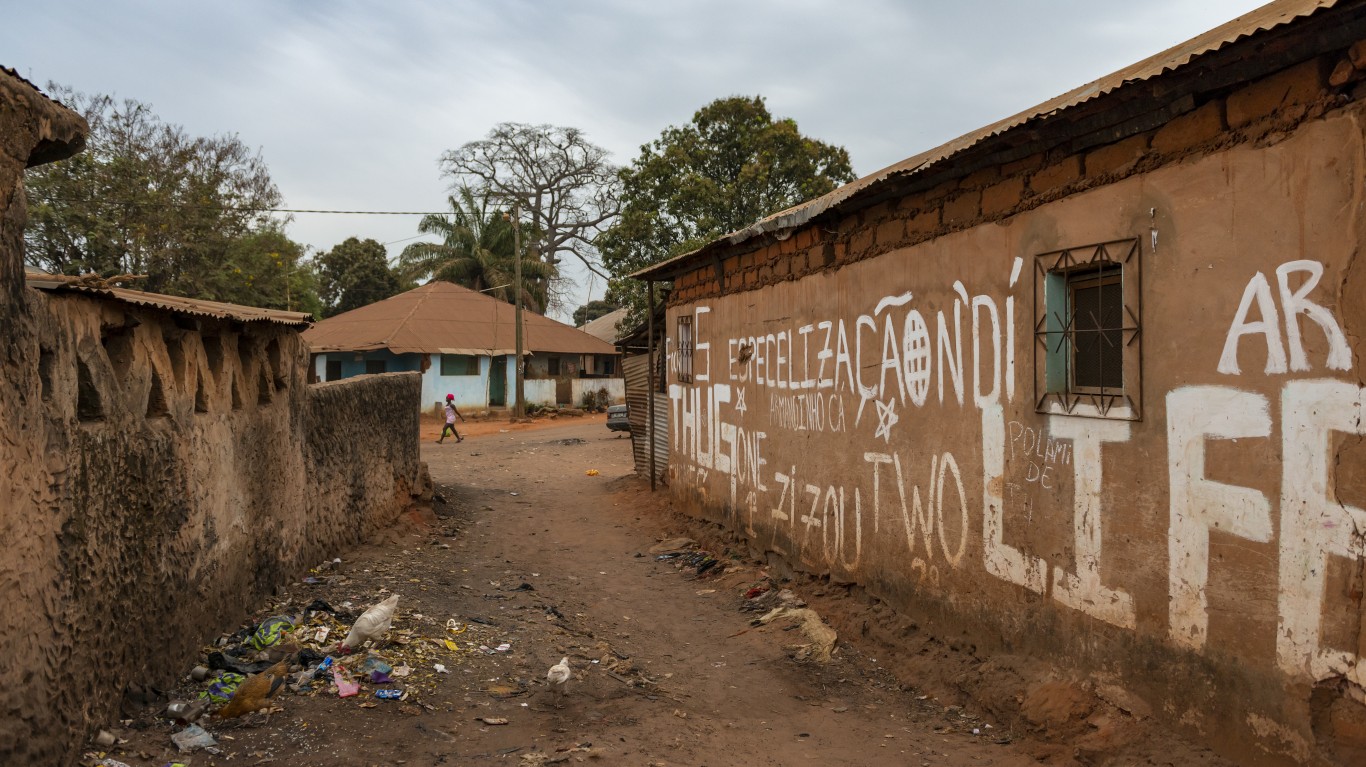
16. Guinea-Bissau
> Catastrophic ecological threats: Three: Food Security; Population; Water Risk
> Global peace index, 2022 (1-5, most to least peaceful): 2.318 – #110 of 163 countries
> GDP per capita, 2021: $813 – #16 lowest of 163 countries
> Human development index: 0.5 – #177 of 191 countries
> Population, July 2021 to 2050: 2.1 million to 3.4 million – 67.2% growth
Situated along the Atlantic Coast of Africa, Guinea-Bissau distinguishes itself from its neighbor Guinea by adding the name of its capital, Bissau. Its overall ecological threat score stands at 5, the highest with three catastrophic ecological threats. The country has the 16th lowest GDP per capita of all countries in the report and has the 15th lowest human development index.
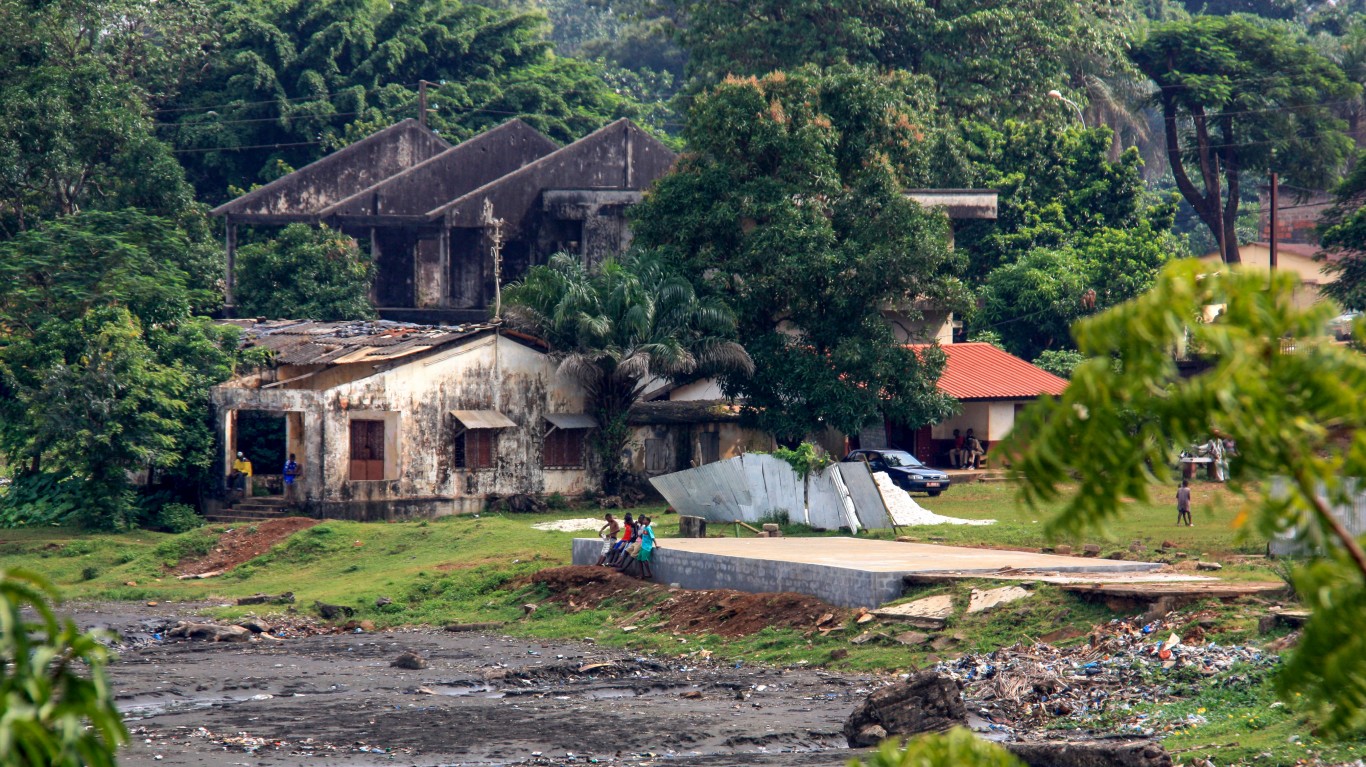
15. Guinea
> Catastrophic ecological threats: Three: Food Security; Population; Water Risk
> Global peace index, 2022 (1-5, most to least peaceful): 2.174 – #123 of 163 countries
> GDP per capita, 2021: $1,174 – #29 lowest of 163 countries
> Human development index: 0.5 – #182 of 191 countries
> Population, July 2021 to 2050: 13.5 million to 23.7 million – 75.2% growth
Guinea is one of six countries in the Sahel region of Africa facing the greatest ecological threats. The Sahel region refers to an area in western and north-central Africa extending from Senegal to the west and east to Sudan, spanning 10 countries. The region is facing numerous social, political and economic vulnerabilities, including high rates of conflict and terrorism. Guinea itself has the 10th lowest human development index.
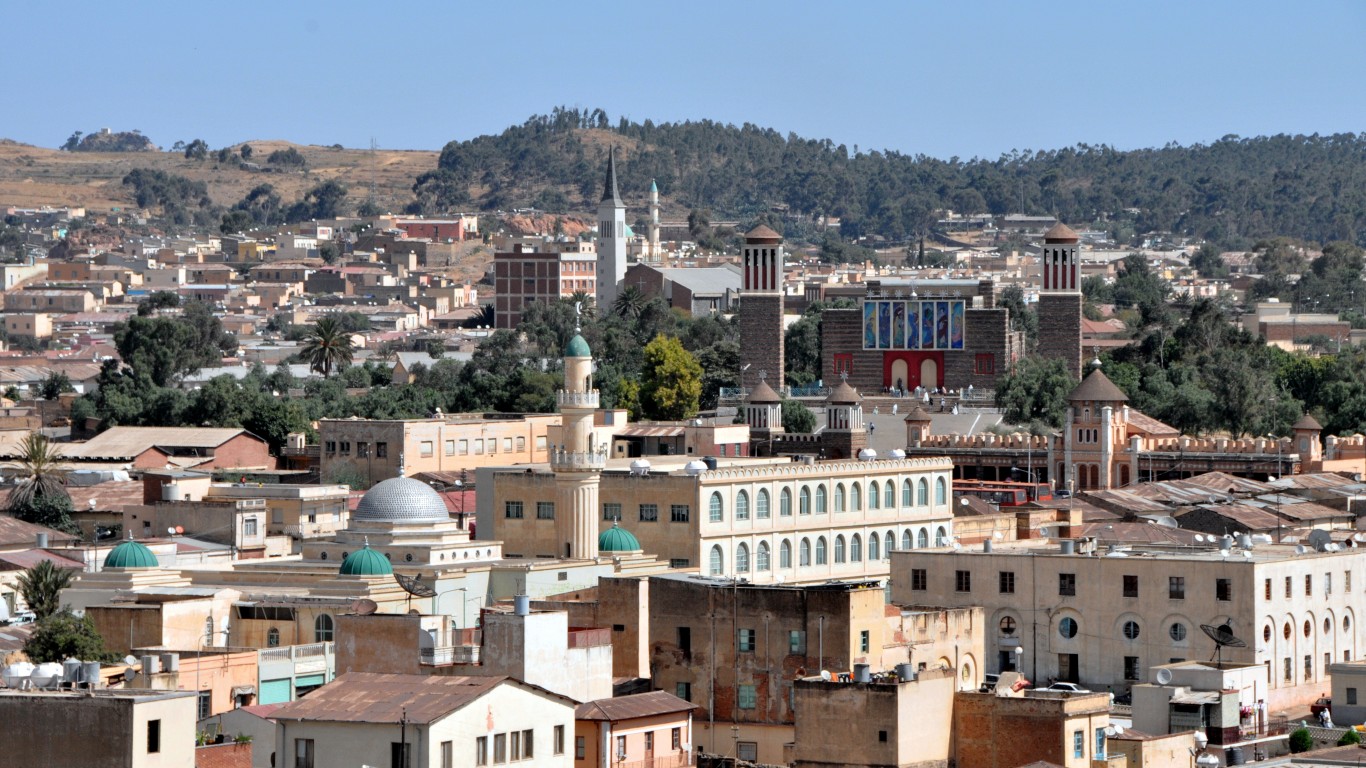
14. Eritrea
> Catastrophic ecological threats: Three: Food Security; Population; Water Risk
> Global peace index, 2022 (1-5, most to least peaceful): 2.405 – #132 of 163 countries
> GDP per capita, 2011: $643 – #10 lowest of 163 countries
> Human development index: 0.5 – #176 of 191 countries
> Population, July 2021 to 2050: 3.6 million to 6.0 million – 64.7% growth
Conflicts between Eritrea and neighboring Ethiopia threaten regional stability. According to a report in the Sudan Tribune, Eritrea is sending troops to the Tigray region of Ethiopia despite Ethiopia signing a peace treaty with the Tigray People’s Liberation Front. Eritrea, which has the 10th lowest GDP per capita of the 163 countries considered, will have the most increase in water stress by 2040.
[in-text-ad-2]
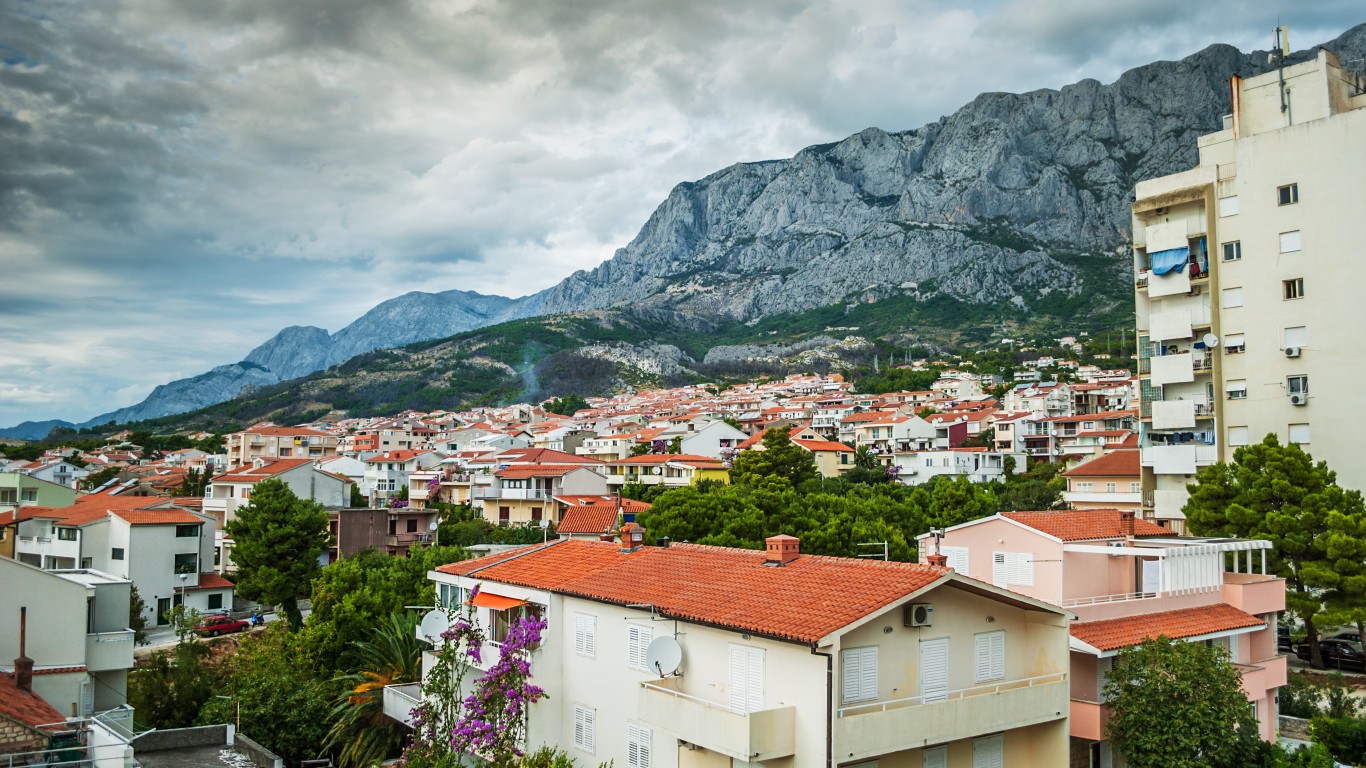
13. Equatorial Guinea
> Catastrophic ecological threats: Three: Food Security; Population; Water Risk
> Global peace index, 2022 (1-5, most to least peaceful): 1.882 – #59 of 163 countries
> GDP per capita, 2021: $8,462 – #63 highest of 163 countries
> Human development index: 0.6 – #145 of 191 countries
> Population, July 2021 to 2050: 1.6 million to 2.8 million – 70.7% growth
Located along the West Coast of Africa, Equatorial Guinea is the only Spanish-speaking nation in Africa and one of the largest oil exporters in sub-Saharan Africa. Yet according to the Borgen Project, 60% of its population earns less than $1 day.

12. Democratic Republic of the Congo
> Catastrophic ecological threats: Three: Food Security; Population; Water Risk
> Global peace index, 2022 (1-5, most to least peaceful): 2.934 – #158 of 163 countries
> GDP per capita, 2021: $584 – #8 lowest of 163 countries
> Human development index: 0.5 – #179 of 191 countries
> Population, July 2021 to 2050: 95.9 million to 217.5 million – 126.8% growth
According to the ETR, the Democratic Republic of the Congo receives 39% of its food imports from low-peace countries, making its food supplies even less secure. Meanwhile, the country’s population is projected to well more than double from 2021 to 2050. Even so, many are leaving, with climate and conflict refugees from the DRC growing. The country’s peace index ranks sixth lowest.
[in-text-ad]
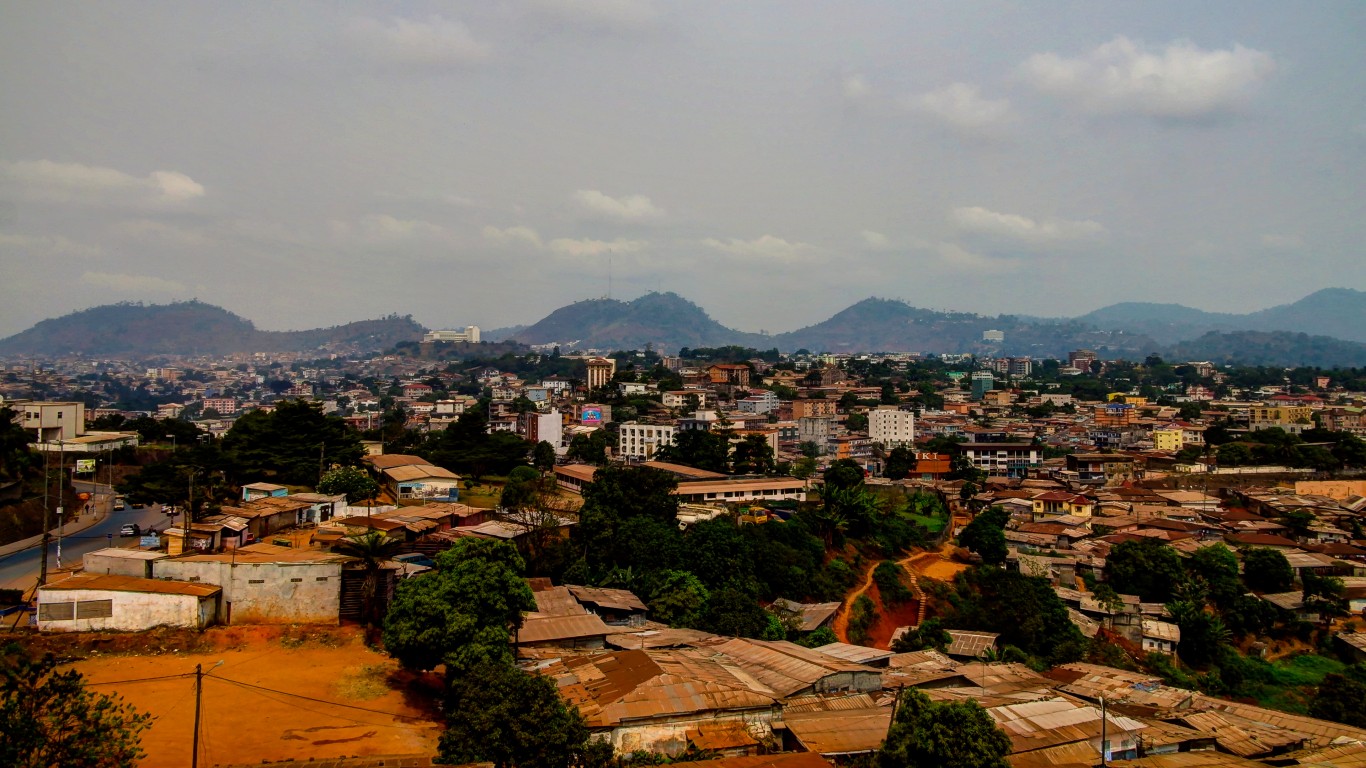
11. Cameroon
> Catastrophic ecological threats: Three: Food Security; Population; Water Risk
> Global peace index, 2022 (1-5, most to least peaceful): 2.017 – #142 of 163 countries
> GDP per capita, 2021: $1,662 – #39 lowest of 163 countries
> Human development index: 0.6 – #151 of 191 countries
> Population, July 2021 to 2050: 27.2 million to 51.3 million – 88.5% growth
Recently, the UNHCR, the U.N. Refugee Agency, named Cameroon as one of 10 countries in the Sahel region of Africa facing hardships due to years of armed conflicts as well as rising temperatures and food insecurity. The other countries are Burkina Faso, Chad, the Gambia, Guinea, Mali, Mauritania, Niger, Nigeria, and Senegal.
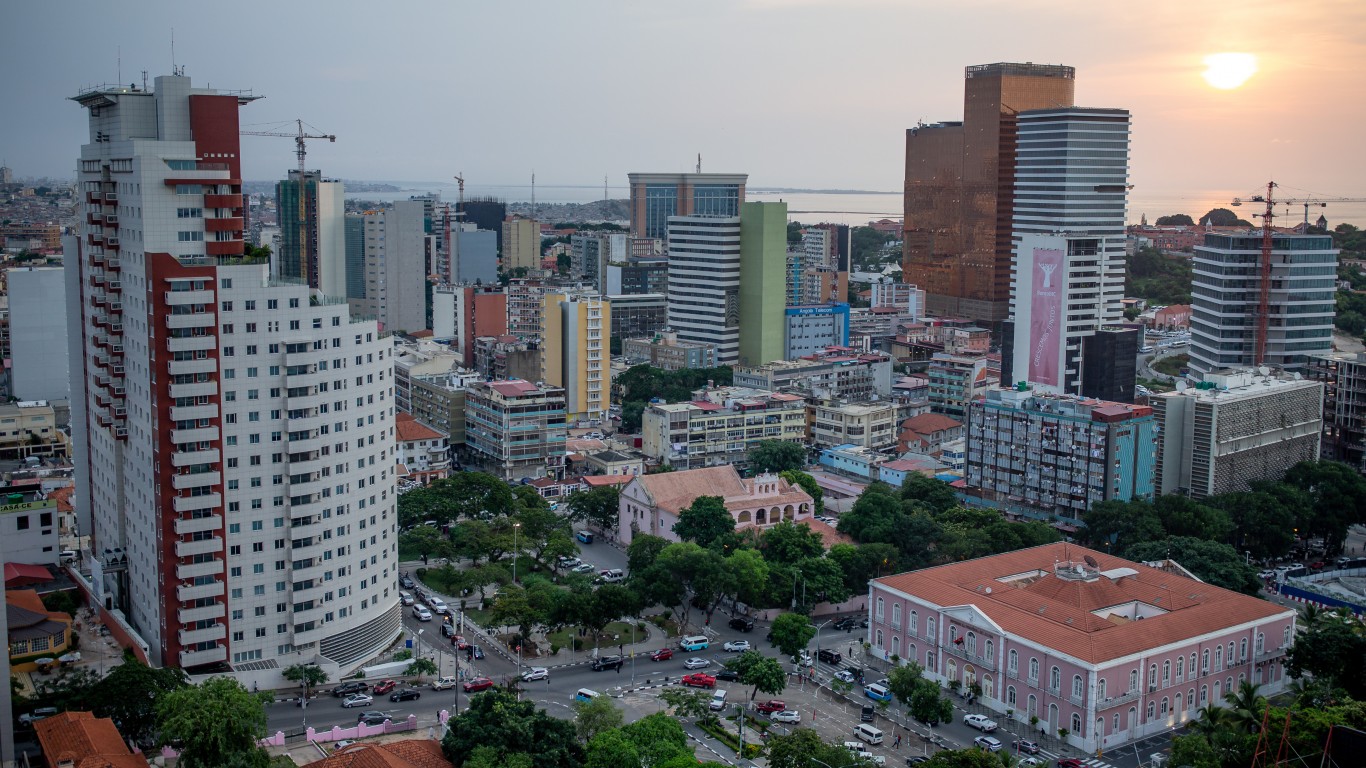
10. Angola
> Catastrophic ecological threats: Three: Food Security; Population; Water Risk
> Global peace index, 2022 (1-5, most to least peaceful): 2.087 – #78 of 163 countries
> GDP per capita, 2021: $2,138 – #47 lowest of 163 countries
> Human development index: 0.6 – #148 of 191 countries
> Population, July 2021 to 2050: 34.5 million to 72.3 million – 109.6% growth
Although Angola struggles with food scarcity and water risk, the country has benefited in one respect. The war in Ukraine has pinched oil supplies, leading to a spike in prices. The ETR report notes this has allowed Angola to pay down its debts. Meanwhile, Angola’s population is projected to skyrocket by 2050, more than doubling. That compares to a global growth rate of 16% by 2050. Meanwhile, the country will also face the most increase in water stress by 2040.

9. Afghanistan
> Catastrophic ecological threats: Three: Natural Disasters; Population; Water Risk
> Global peace index, 2022 (1-5, most to least peaceful): 3.154 – #163 of 163 countries
> GDP per capita, 2020: $517 – #7 lowest of 163 countries
> Human development index: 0.5 – #180 of 191 countries
> Population, July 2021 to 2050: 40.1 million to 74.1 million – 84.7% growth
Internal conflicts and natural disasters displaced 3 million refugees from Afghanistan in 2021, the ETR reports. Many of those displacements were prompted by the U.S. withdrawal after 20 years of war. The Taliban now rules the country, which ranks absolute last in the peace index. It also has the seventh lowest GDP per capita of the 163 countries in the report and among the lowest human development. Afghanistan, which already experienced an increase in the number of natural disasters since 1981, is expected to see the most increase in water stress by 2040.
[in-text-ad-2]
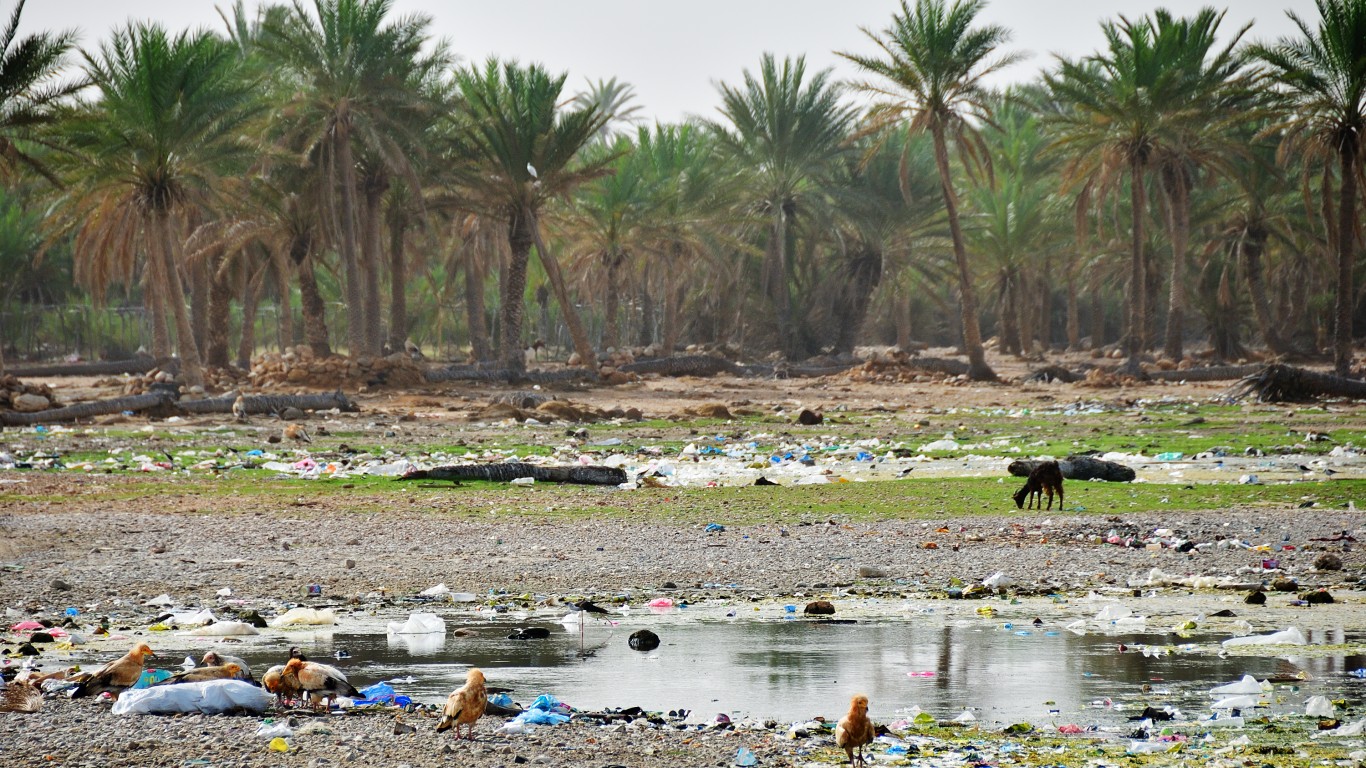
8. Yemen
> Catastrophic ecological threats: Four: Food Security; Natural Disasters; Population; Water Risk
> Global peace index, 2022 (1-5, most to least peaceful): 2.609 – #162 of 163 countries
> GDP per capita, 2021: $691 – #13 lowest of 163 countries
> Human development index: 0.5 – #183 of 191 countries
> Population, July 2021 to 2050: 33.0 million to 55.3 million – 67.7% growth
Noted by the ETR as being among the eight countries with four catastrophic ecological threats, a civil war has ravaged this country on the Arabian Peninsula for eight years. The ongoing conflict is between the country’s government, supported by Saudi Arabia, and Houthi rebels backed by Iran. The war has resulted in an ongoing humanitarian crisis. As a result, the country ranks second to last in the peace index, with one of the lowest GDP per capita. The country will also face the most increase in water stress by 2040 as well as among the most conflicts as a result.
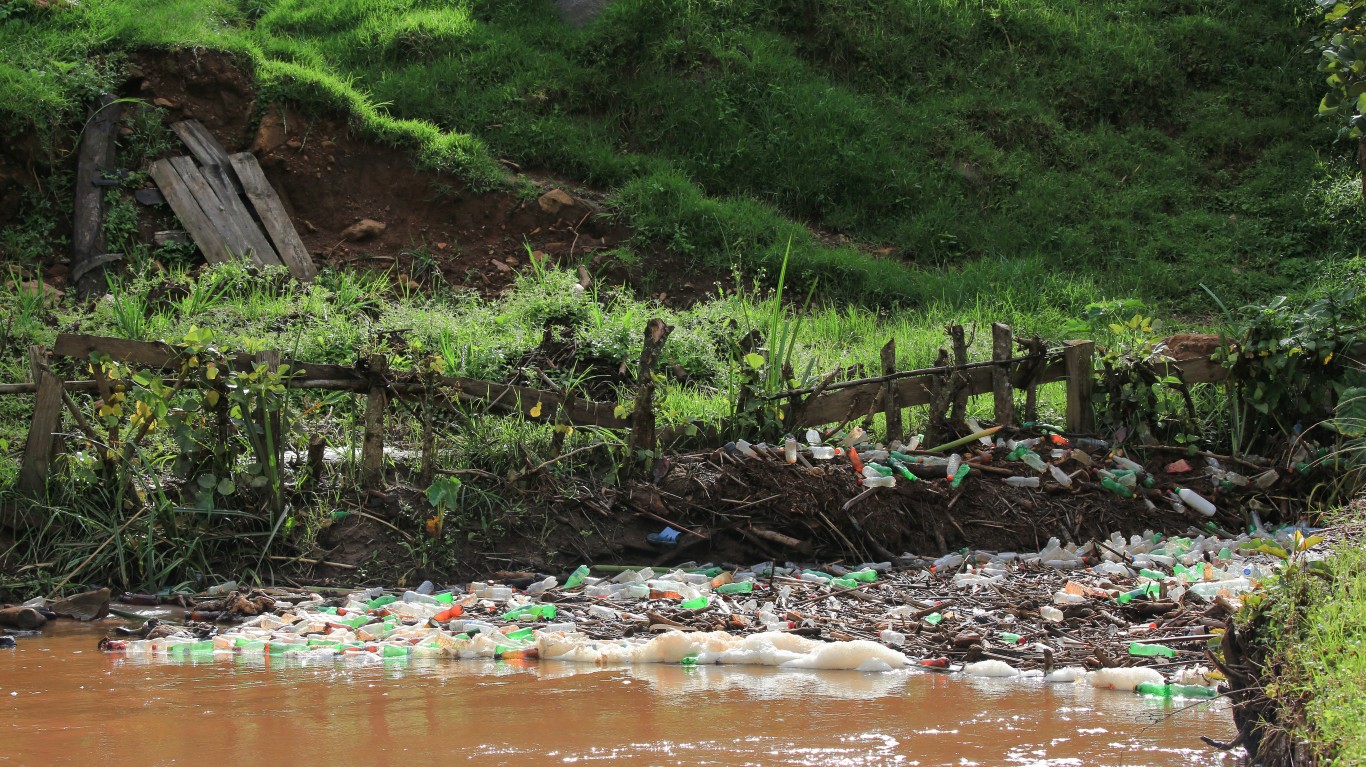
7. Uganda
> Catastrophic ecological threats: Four: Food Security; Natural Disasters; Population; Water Risk
> Global peace index, 2022 (1-5, most to least peaceful): 2.277 – #121 of 163 countries
> GDP per capita, 2021: $858 – #19 lowest of 163 countries
> Human development index: 0.5 – #166 of 191 countries
> Population, July 2021 to 2050: 45.9 million to 87.6 million – 91.1% growth
In September, Uganda was hit by a natural disaster when heavy rains caused landslides in the western part of the country. Sixteen people reportedly died. The sub-Saharan country received the most refugees in 2021, mostly from neighboring countries – at least 1 million. The country also relies on food imports from low peace countries.
[in-text-ad]

6. South Sudan
> Catastrophic ecological threats: Four: Food Security; Natural Disasters; Population; Water Risk
> Global peace index, 2022 (1-5, most to least peaceful): 2.315 – #159 of 163 countries
> GDP per capita, 2015: $1,120 – #25 lowest of 163 countries
> Human development index: 0.4 – #191 of 191 countries
> Population, July 2021 to 2050: 10.7 million to 17.5 million – 62.5% growth
Three of the eight subnational areas facing the worst ecological catastrophes are located within South Sudan. That includes the Jonglei State, its most populous region with nearly 3 million people. South Sudan faces four catastrophic ecological threats and is among the countries that had the highest levels of internal displacement from both conflict and natural disasters in 2021. The country is the fifth least peaceful and among the poorest countries in the world. It also ranks absolute last on the human development index.

5. Somalia
> Catastrophic ecological threats: Four: Food Security; Natural Disasters; Population; Water Risk
> Global peace index, 2022 (1-5, most to least peaceful): 3.228 – #156 of 163 countries
> GDP per capita, 2021: $446 – #2 lowest of 163 countries
> Human development index: N/A
> Population, July 2021 to 2050: 17.1 million to 36.5 million – 113.7% growth
In 2021, a famine gripped Somalia, killing 260,000 people. Half of those who died were children. With a drought and rising food prices, the country faces another food crisis, warns Save the Children. Somalia, which faces four catastrophic ecological threats, is among the countries with the most water-related conflicts over the last two decades. Such conflicts are most likely to continue, the report notes. The country has the second lowest GDP per capita of the 163 countries considered in the report.
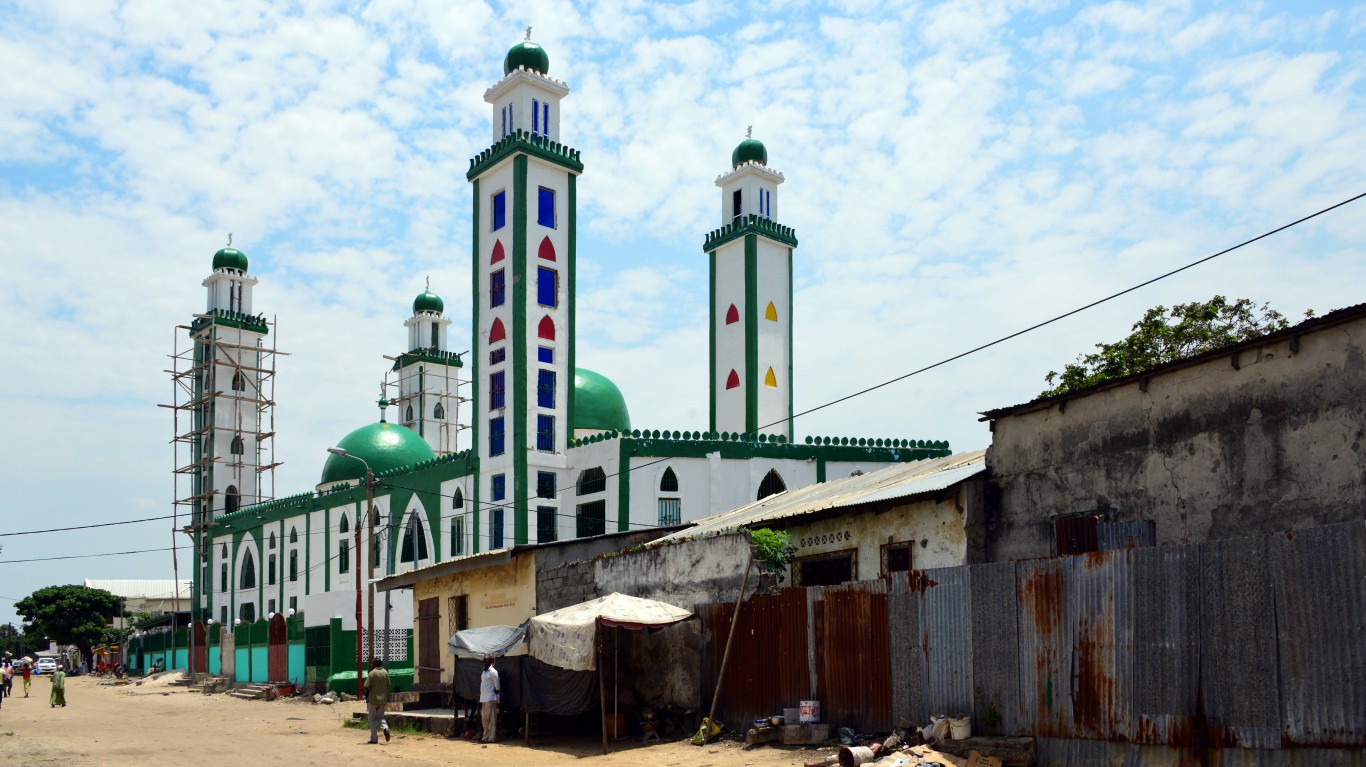
4. Republic of the Congo
> Catastrophic ecological threats: Four: Food Security; Natural Disasters; Population; Water Risk
> Global peace index, 2022 (1-5, most to least peaceful): 2.056 – #111 of 163 countries
> GDP per capita, 2021: $2,214 – #48 lowest of 163 countries
> Human development index: 0.6 – #153 of 191 countries
> Population, July 2021 to 2050: 5.8 million to 10.4 million – 77.8% growth
The Republic of the Congo received its independence from France in 1960. To distinguish itself from the neighboring Democratic Republic of the Congo, the country is also known as Middle Congo or Congo-Brazzaville – Brazzaville being its capital. The country is among those that face low domestic food security and low socio-economic resilience and are projected to be most affected by breakdowns in the food supply chain due to conflict.
[in-text-ad-2]
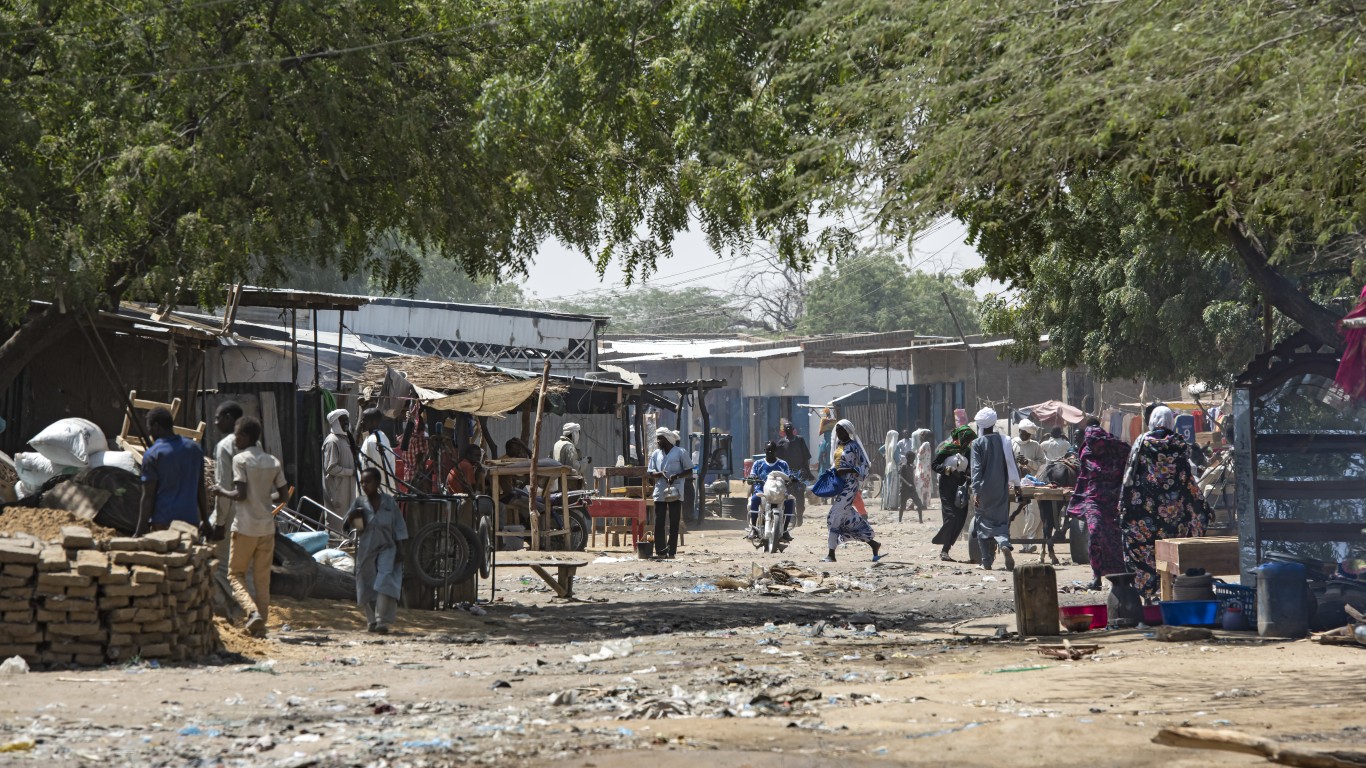
3. Chad
> Catastrophic ecological threats: Four: Food Security; Natural Disasters; Population; Water Risk
> Global peace index, 2022 (1-5, most to least peaceful): 2.612 – #136 of 163 countries
> GDP per capita, 2021: $696 – #14 lowest of 163 countries
> Human development index: 0.4 – #190 of 191 countries
> Population, July 2021 to 2050: 17.2 million to 36.5 million – 112.2% growth
After completing a $4 billion pipeline linking its oilfields to terminals along its Atlantic Coast, Chad became an oil-producing country. Yet the country has been plagued by conflicts between the Arab-Muslim population in the north and the Christian population in the south. Still, Chad’s population is expected to explode, more than double by 2050.
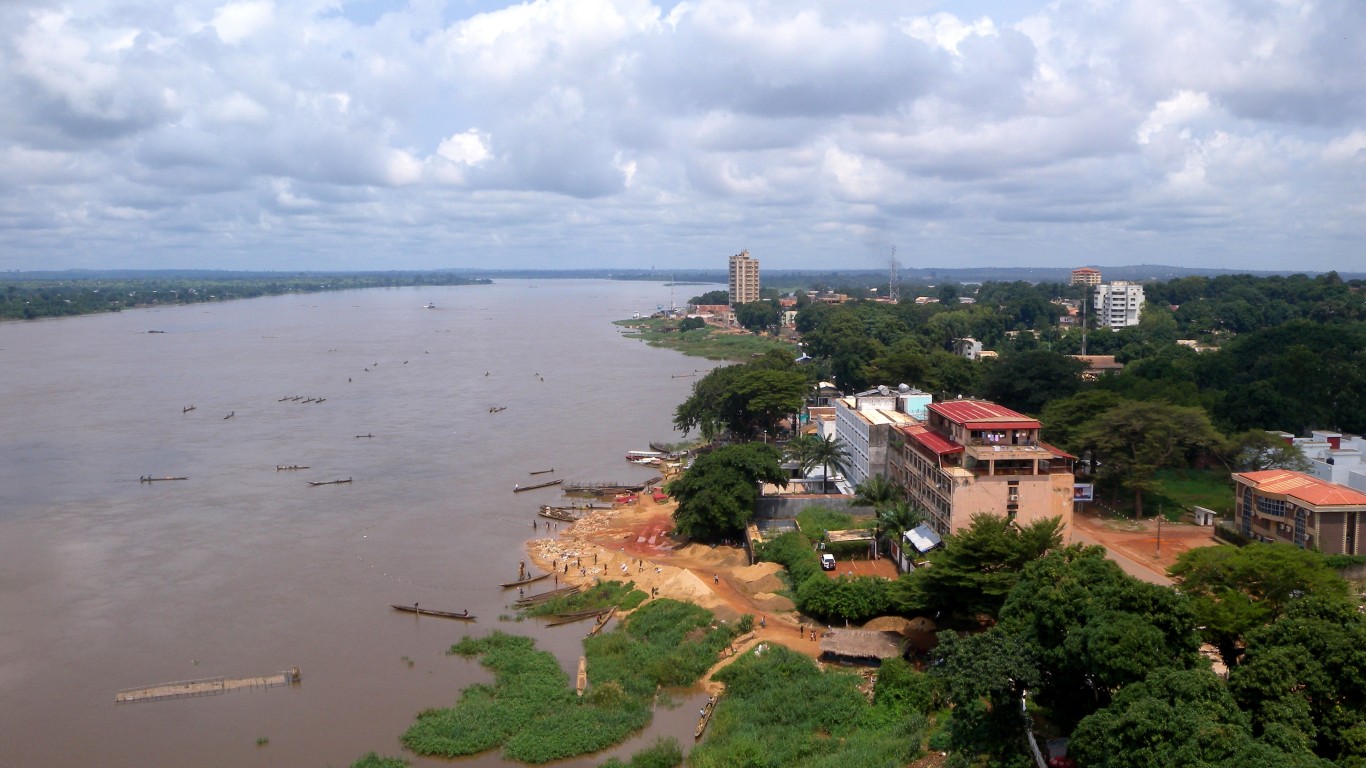
2. Central African Republic
> Catastrophic ecological threats: Four: Food Security; Natural Disasters; Population; Water Risk
> Global peace index, 2022 (1-5, most to least peaceful): 2.780 – #155 of 163 countries
> GDP per capita, 2021: $511 – #4 lowest of 163 countries
> Human development index: 0.4 – #188 of 191 countries
> Population, July 2021 to 2050: 5.5 million to 11.5 million – 111.3% growth
Since June, floods have besieged the Central African Republic, reports the U.N. The floods have affected 85,300 people, destroyed some 2,600 homes, damaged infrastructure and crops. The country ranks among the 10 lowest in the peace index and has the fourth lowest GDP per capita of the 163 countries in the report. It also ranks fourth lowest in the world in human development. Even so, the population is expected to more than double by 2050.
[in-text-ad]

1. Burundi
> Catastrophic ecological threats: Four: Food Security; Natural Disasters; Population; Water Risk
> Global peace index, 2022 (1-5, most to least peaceful): 2.290 – #131 of 163 countries
> GDP per capita, 2021: $237 – #1 lowest of 163 countries
> Human development index: 0.4 – #187 of 191 countries
> Population, July 2021 to 2050: 12.6 million to 24.2 million – 92.9% growth
Burundi gained its independence from Belgium in 1962, but since then conflicts between Hutu and Tutsi populations have marred the country’s stability. The country has the lowest GDP per capita of the 163 countries considered in the report. It is facing four catastrophic ecological threats, including a nearly doubling of its population by 2050.
Methodology
To find the 27 countries that face catastrophic ecological threat, 24/7 Wall St. reviewed the global think tank Institute for Economics & Peace report Ecological Threat Report 2022. The report identified 27 hotspot countries that face catastrophic ecological threats, while also having the lowest levels of societal resilience. Countries are ordered by the number of catastrophic ecological threats in reverse alphabetical order.
The report, which covers 163 countries, was developed to identify countries at the highest risk of ecological threats, including water and food risk, population growth, and disasters from natural events. These threats are combined with levels of resilience: ongoing domestic and international conflict, societal safety and security, and militarization.
From another Economics & Peace report, the Global Peace Index 2022, we added each country’s GPI, which is on a scale of 1-5, whereas 5 is least peaceful. From the World Bank, we added gross domestic product per capita in current U.S. dollars. From the United Nations we added both the Human Development Index of each country. The HDI uses health, education, and economic measures to assess a country’s development. We also used the U.N.’s World Population Prospect 2022 to list the 2021 and projected 2050 population of each country.
Full citation: Institute for Economics & Peace. Ecological Threat Report 2022: Analysing Ecological Threats, Resilience & Peace, Sydney, October 2022. Available from: http://visionofhumanity.org/resources (accessed 15 Nov. 2022).
Credit Card Companies Are Doing Something Nuts
Credit card companies are at war. The biggest issuers are handing out free rewards and benefits to win the best customers.
It’s possible to find cards paying unlimited 1.5%, 2%, and even more today. That’s free money for qualified borrowers, and the type of thing that would be crazy to pass up. Those rewards can add up to thousands of dollars every year in free money, and include other benefits as well.
We’ve assembled some of the best credit cards for users today. Don’t miss these offers because they won’t be this good forever.
Flywheel Publishing has partnered with CardRatings for our coverage of credit card products. Flywheel Publishing and CardRatings may receive a commission from card issuers.
Thank you for reading! Have some feedback for us?
Contact the 24/7 Wall St. editorial team.
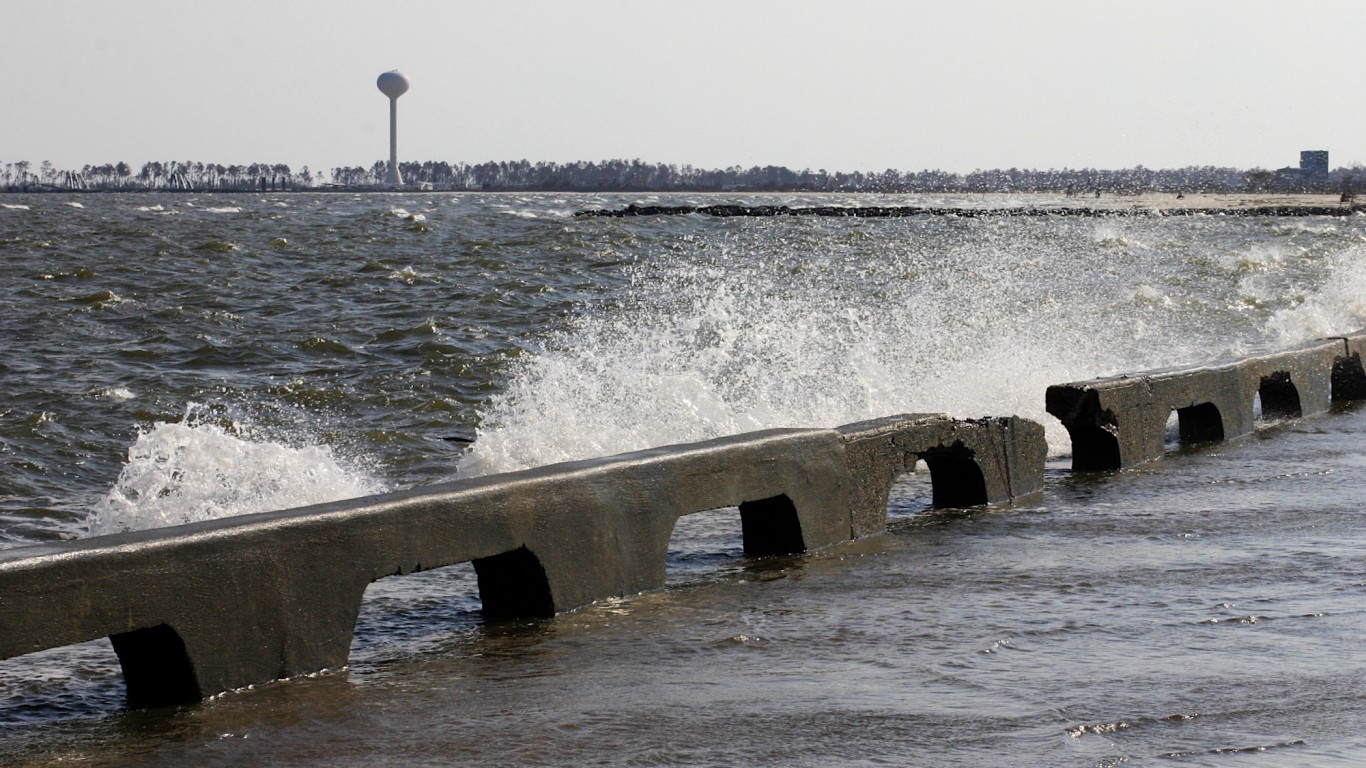 24/7 Wall St.
24/7 Wall St.
